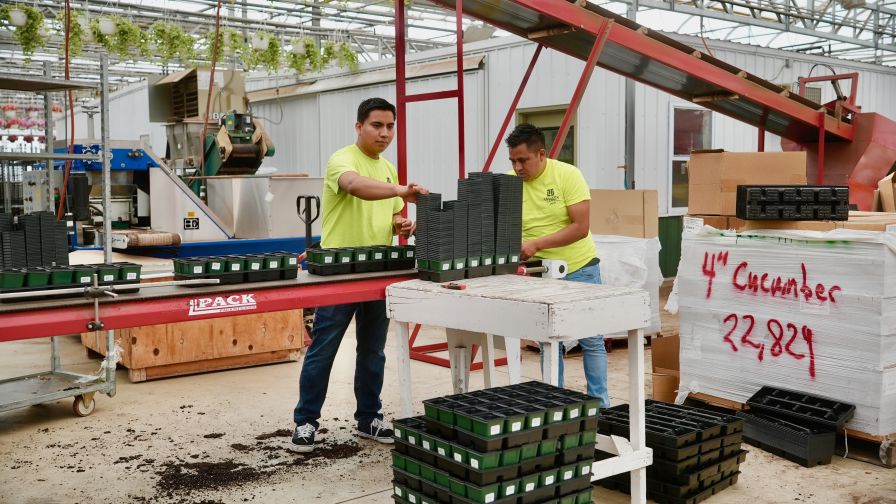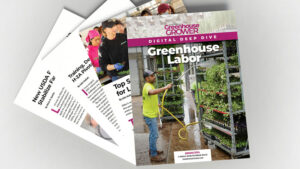Training, Development, and H-2A Are Pivotal in the Greenhouse Labor Market

Legacy Labor provides H-2A workers throughout the country, including operations in Kalamazoo, MI. Photo: Legacy Labor, Inc. / Montage Media
If you escaped 2023 without labor challenges, you have a secret recipe that competitors would give anything to know. The labor market has been strained for years across all industries, not just floriculture. But, floriculture is especially challenging due to its physical labor, repetitive tasks, and long hours. Growers have grappled with finding enough workers to complete day-to-day tasks.
Thankfully, it’s not all doom and gloom. There are several labor solutions on the horizon, and growers are learning how to leverage their resources and take advantage of these opportunities. By focusing on training and development, and joining the H-2A program, grower operations are building the next generation of leaders.
Training and Development Are Key
Geneiva McNeale, Owner and CEO of GLM Leadership Solutions, says training and development are two different things. Training refers to how employees do their jobs, while development considers what the job could be, including long-term professional growth.
Different positions require different types of training and development, McNeale says. For example, general laborers need to be trained on how to stick cuttings, but they still want to feel engaged and contribute a human value to the company, not just a dollar value.
In other cases, a breeder or soil scientist would likely be well-versed in their field due to graduate degrees, but they may benefit from other skills, such as interpersonal communication or leadership.
With a lot of companies looking to develop their teams, it can be bigger than just the leadership skills, and more about the leadership culture. It is common to have a feeling of “in” or “out” at family businesses, McNeale says. Members of the family and family friends may feel entitled, and other employees may not feel respected for their expertise. In this case, it is best to have an intervention with a consultant where employees can speak openly without fear of losing their job.
“You need to trust the newcomers,” McNeale says. “Instead of trying to do training on how to lead your team, it’s more of a team intervention. You bring people together in a room of trust and talk about it, giving space for a mediator or conflict specialist to bring out those conversations.”
Paige Franks, Benjamin Molenda, and Harrison Downing are the next generation of leaders at BEST Human Capital & Advisory Group. Franks also noted that many floriculture businesses are family owned. In this case, younger people may see a cap on their growth.
“If they don’t have the room to grow, that is a turn off,” Franks says. “They could stay there for two to five years and treat it as a stepping stone.”
Another challenge is work-life balance, Franks says. When recent graduates hear about six- or seven-day workweeks, they are not interested in the job. Growers have noticed this trend and are working to incorporate more work-life balance into their positions.
Downing has noticed that many hires are reactive, meaning someone left and the company is trying to replace them, rather than proactive hires. By planning in advance, a company can identify rising stars, train them over time, then they will move into a leadership role.
“Everybody wants five years of experience in horticulture. But how do you get that experience just out of college?” Downing says. “Maybe there are five unique factors a company wants a candidate to have, but the hiring manager could stick to three that are the most important. Then you can train or develop the fourth and fifth points and add them in over time.”
H-2A Offers Labor Pool
“Labor is one of the most important topics for the sustainability of the market,” says Justin Bartlett, Co-CEO and Director of Sales and Marketing for Legacy Labor. “We need to get crops to market and have a reliable workforce. It’s a huge component of everyone’s business and the shortage is at the forefront of everyone’s mind. One of the things that is a solution is the H-2A market.”
Participating in the H-2A program is the solution to an operation’s labor needs, he says. However, due to increased regulation, the H-2A program is becoming more difficult to use. A 5% to 7% average annual increase in the adverse effect wage rate (AEWR) is not sustainable, Bartlett says. Even though each administration in the federal government adjusts regulations within the H-2A program, it is not going anywhere. The number of visas issued every year keeps going up.
“When someone switches to H-2A, they don’t switch back,” Bartlett says.
The H-2A program provides a reliable labor solution, says Megan Wright, Senior Director of Industry Relations at masLabor.
“Each operation is unique, so it does take initial commitment and education on the employer’s part, to ensure program compliance. That said, when the same crew hits the ground running each year, it all comes together,” Wright says. “We want employers to understand that you’re providing benefits like free housing and transportation, along with a set wage rate, for example. But if you’re willing to participate, you have the peace of mind that these people are coming for the right reasons. You’re creating long-lasting relationships.
The H-2A program also encourages domestic job growth and stability, Wright says. When a business has a reliable workforce, additional opportunities will surely follow.
When Lawrence Williams, Owner of Manzana, thinks about the future of labor in floriculture, he says the “ever-changing AEWR” comes to mind. He describes the AEWR as the biggest obstacle for labor providers.
“In Michigan, when I started in 2015, the AEWR was $11.56,” Williams says. “This year, the proposed increase will make it $18.50. It’s making it so growers cannot afford to pay this AEWR and it’s making it tough for them to use H-2A.”
During a December conference in Las Vegas for the National Council of Agricultural Employers, attendees were told to contact their local representatives to advocate for the H-2A program and making it accessible for all growers.
“Everyone should get a hold of their local representative, such as a congressman or senator,” Williams says. “Don’t make a call just once, be that squeaky wheel. Get your friends and peers to call. Keep putting pressure on them so politicians understand what we’re going through just to survive in this industry.”
Despite challenges with H-2A regulations, Williams looks fondly toward the future of floriculture. Growers are a resilient, resourceful, and intelligent community who collaborate to find solutions, he says.










